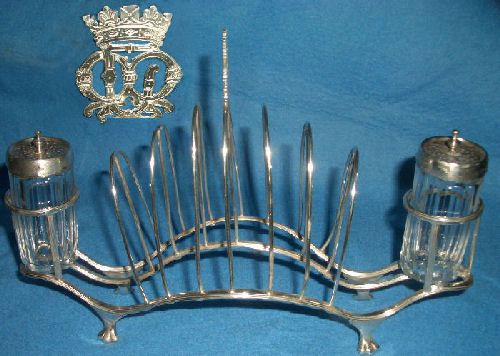This is my first post or rather my first post which I deleted from the forum “Collecting British silver”. I figured this forum is likely a better fit for my query. I hope I did nothing wrong by removing from the other and listing it here.
Would appreciate if anyone might be able to identifying the maker of this toast rack. I am a novice when it comes to silver, I hope that I have read the hallmark correctly. I believe it was made in Sheffield in 1881 and reads as follows:
WB in a diamond for maker - unknown, lion - sterling quality, date letter O - for 1881, crown - for Sheffield, Victoria - soveriegn.
The hallmark is on one end of the center runner, on the opposite end is inscribed in uppercase “WHITE, BOND ST”. The letter T is uppercase in style but smaller with a period underneath. I am guessing WHITE was a merchant on Bond St.?
Lastly the carrying handle ends with a crown, center Maltese cross flanked by fleur de lys and half maltese cross on each end.,below are dimond and oval shapes am guessing representing diamonds. Below is a monogram which is hard to read, something like GCO , but I am unsure of the letters.
The 2 glass jars with silver caps were made in Birmingham 1881 LC maker.
Thank you all for your patience and time.


Welcome to the forum, Eddie. No, you did nothing wrong by moving your post. I agree that this is the more logical place.
WB is the maker’s mark of John Harrison & Co Ltd of Norfolk Works, Scotland Street, Sheffield, this mark being registered in 1880. I’m not sure whose initials WB were but it is possible that they are because of a change of ownership. The company subsequently (1883) reverted to a mark with the initials JH&Co.
The “WHITE, BOND ST” mark sounds like a retailer’s mark, Bond Street being then, as it is now, one of the classier streets in London.
Sorry, I can’t help with a suggestio for LC.
Wondering if they are the original glassware for this arrangement?
However, SMM, really confused about this … W.B in a diamond shape, is the mark for John Harrison & Co of Sheffield? I thought JH&Co (Sheffield) was for Joseph Haywood?
I would be grateful for a reference for ‘W.B’ & John Harrison please
Many thanks in advance
John
John,
My reference for Sheffield marks up to 1907 is the The Sheffield Assay Office Register by B.W. Watson, published by Wm Townsend & Sons, Sheffield, 1911.
Haywood’s JH&Co is in an elongated shield-shaped punch, Harrison’s is in a rectangular punch.
Phil
Of course, makes sense now.
Many thanks
John
Hello SMM,
First off thank you for the information. I would never have found it, as I would have kept searching for WB. I was under the impression that the WB was most important to finding maker or manufactuer. From the hallmarks I would have never thought of John Harrison nor would I have looked at punch styles.
I did some searching and found the following on John Harrison (Norfolk Works, Scotland St.). He was the father of Wheatcroft Harrison (W.W.) and that they were in business together. The info mentioned the business was established 1820, with marks entered into the Assay office Sheffield for 1833, 1844. I was not able to find the 1880 mark. It also mentioned that he retired in 1858 and that the son W.W. then went into partnership with John Maleham Harrison. That partnership disolved 1870 with W.W. going to Montgomery Works and John Maleham Harrison to Norfolk Works.
Is the maker of the toast rack John Harrison father of W.W. or John Maleham Harrison?
I would guess that the business established 1820 could be in operation in 1881 under new ownership as you mentioned regarding the WB. I really do appreciate your time.
Lastly Is there one book which a novice could purchase that would be a good all round information supplier regarding silver?
Thank you very much.
Hello John,
Regarding the glassware. I am not sure if they are original to the toast rack, but they do fit quite nicely as if they were made for the slots. My guess is not original, rather commissioned for the piece in 1881 most likely by the original buyer. I would think that if the merchant had commissioned them they would have a London hallmark. My guess is the original owner bought them in London and upon their return to Birmingham had the jars commissioned. The fit is almost perfect. Given that I believe they were made for the rack, I will keep them together.
Eddie
I would find it very difficult to recommend a single book (or even 2 or 3) which would give an all-round appreciation of silver. It is such a large subject that a multi-volume work would be required to do the subject justice - and as far as I know such a work does not exist. For British silver I guess the best work would be Jackson’s Silver and Gold Marks of England, Scotland and Ireland (note that there is a Pocket Edition which does not have anything like the same depth). Even this has its drawbacks as it has a fair bit about early silver marks which we hardly ever see outside of museums.
Sponsor’s marks (as maker’s marks should properly be termed) do not necessarily indicate the silversmith himself. In the case of Harrison & Co, WB was probably an interim proprietor who may never even have got his hands dirty in the workshop. The company would have employed a number of silversmiths, journeymen and apprentices any one of whom may have had a hand in the manufacture of your toast rack. It’s a bit like buying a Ford automobile and wondering which of Henry’s grandsons made it!